According to installers we trust, what are the best EV charger brands in Australia in 2025?
It was tough competition for the top spot – with only a handful of votes separating first and third place. Find out the winners below.
How Did We Survey Our Installers?
We asked the 594 installers in the SolarQuotes installer network one question:
If installing a system on your own house today, what brand’s EV chargers would you use?
140 replied – here’s the results.
Best EV Chargers In Australia: 2025
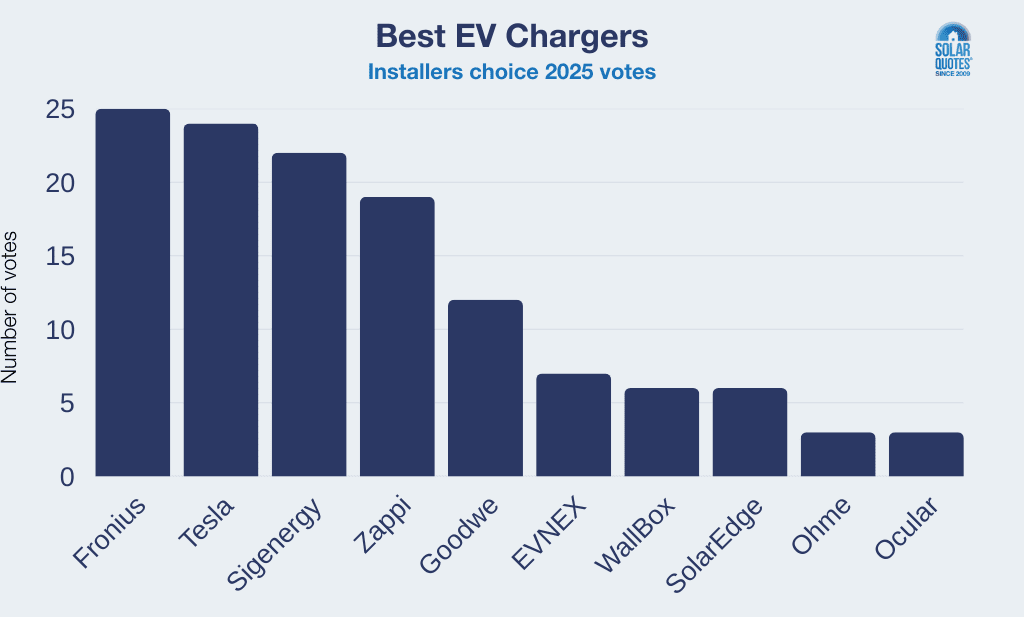
Not shown: Brands that received only one vote
Best EV Chargers 2025: First place – Fronius
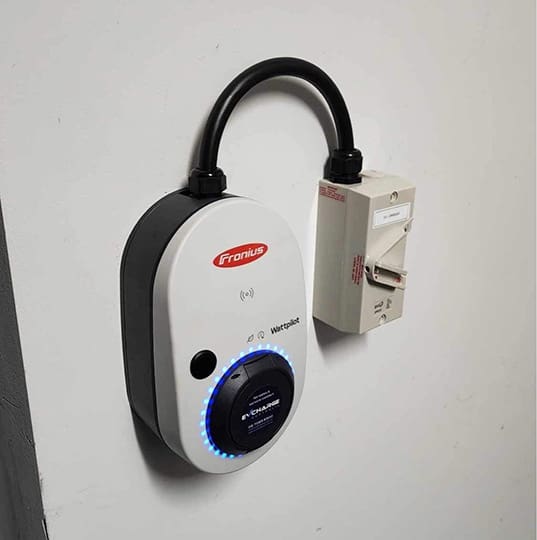
Fronius products have a fantastic reputation
With 18% of the vote, Fronius has claimed the top spot this year.
With a legendary reputation for quality, it’s no surprise many installers see the Fronius Wattpilot charger as the natural charger choice for a Fronius household. It comes in a hard-wired and portable variant (the Wattpilot GO).
Keeping things within an ecosystem means you have one point of contact for warranty issues and only one app to use on your phone.
The downside? It’s one of the more expensive chargers on the market—around $1,800. This also makes its two-year warranty disappointingly short for the price.
Best EV Chargers 2025: Second place – Tesla
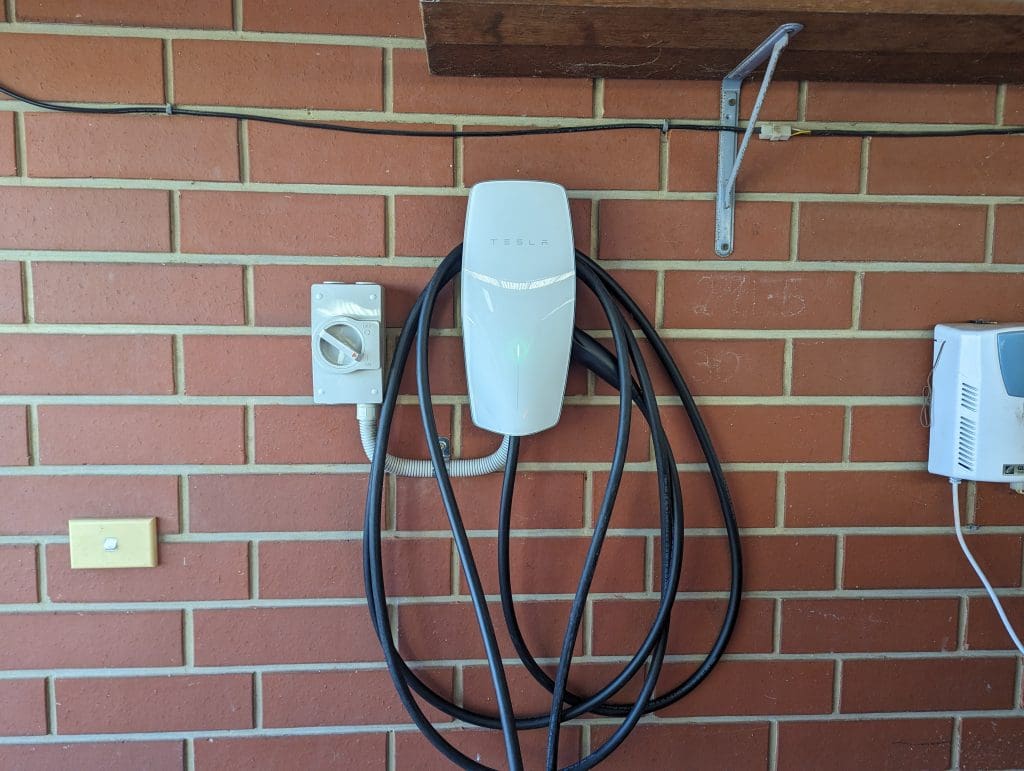
Tesla’s Wall Connector in the wild
Taking second place with 17% of the vote is Tesla with their Wall Connector.
Tesla offers one of the cheapest name-brand chargers on the market.
The Tesla Wall Connector costs $800 and comes with a four-year warranty.
This makes it easy to recommend if you have a Tesla car and a Tesla Powerwall.
If you don’t have a Tesla car and Powerwall, the wall connector is a ‘dumb’ charger—for now. That’s because almost all the charging smarts are communicated directly between the battery (which knows your consumption and solar generation) and the car (which sets the charging speed), bypassing the wall charger.
If you have a Tesla, you can make the charger smart without buying a Powerwall by using the ChargeHQ app which can talk to most solar inverters and your Tesla car – but that has an ongoing monthly subscription fee of $7.
Best EV Chargers 2025: Third place – Sigenergy
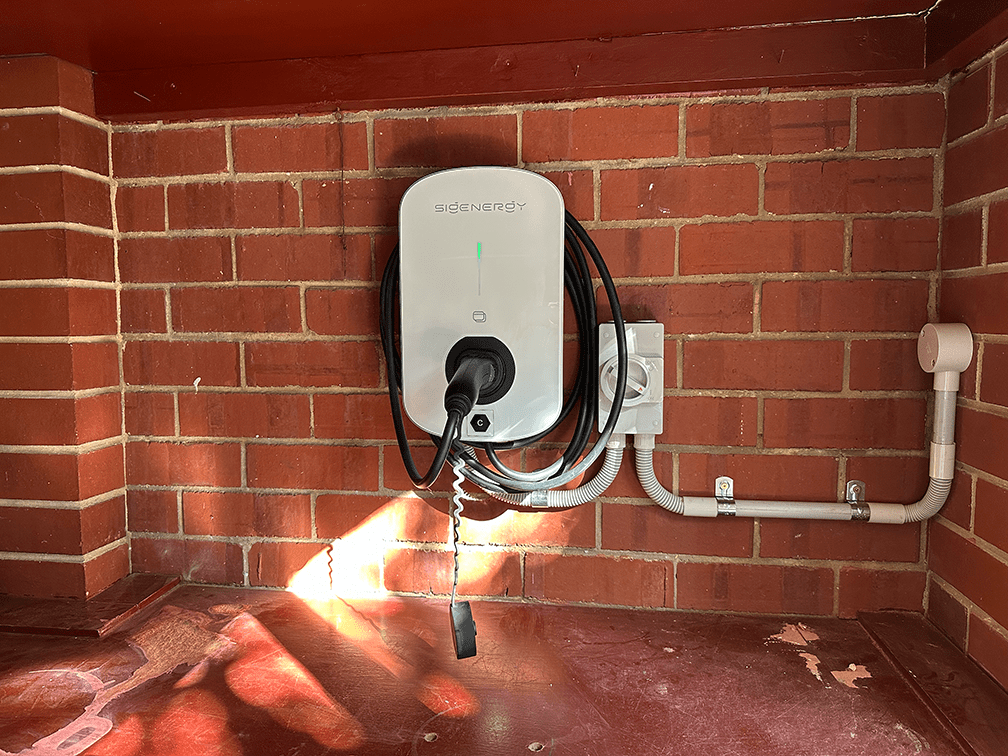
A Sigenergy AC charger.
Sigenergy is a new brand in Australia that has experienced a fast rise in popularity. It’s impressive that it took third place with 16% of the vote in its first year in the country.
Sigenergy offers both AC and DC charger options. I was impressed with how easy their 25kW bi-directional ready DC charging unit was to install and commission—it worked flawlessly the first time.
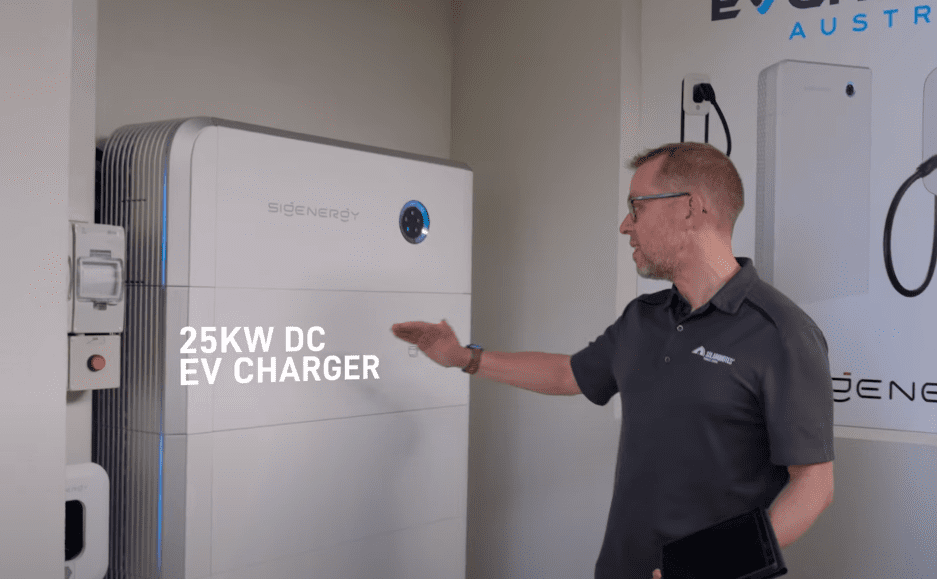
The downside of the DC charger is that it’s part of the Sigenstor battery/inverter stack, meaning it must be installed near where your EV parks.
Both their AC and DC chargers are OCPP enabled, so they can use third-party apps like ChargeHQ.
Price-wise, the 25kW DC charging module runs an eye-watering $8,600, while the single-phase AC charger runs a much more reasonable $1,200.
SQ employee Jono just had the AC charger installed at his place. Watch this space for the video of his installation coming soon.
What Do These EV Chargers Cost?
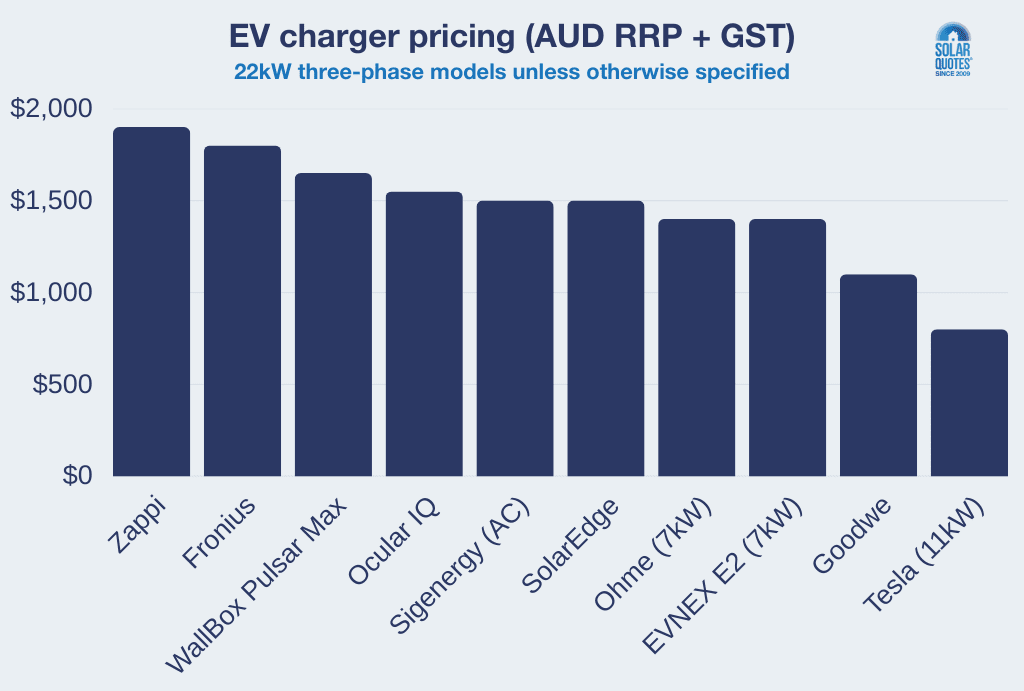
Not shown: Sigenergy’s $8,600 25kW DC module (it throws the graph out of scale!)
My EV charger comparison table shows pricing for all the winners plus heaps of other brands.
To compare this year’s winners:
- Fronius Wattpilot – $1,800
- Tesla Wall Connector – $800
- Sigenergy AC charger – $1,500
- Sigenergy DC charger (25 kW) – $8,600
These prices don’t include installation costs, which vary depending on the complexity of the job.
An easy install—with a pre-wired garage—could cost as low as $600. A harder install involving long cable runs, dynamic load control and underground trenching could cost as much as $4,000.
Wrapping up
Congratulations to this year’s winners.
You now know which brands installers prefer, but what do the Australian people prefer? Find out in our top 10 EV charger brands according to Australian reviewers.
For more of the best picks from the 2025 Installers’ Choice Awards, take a look at the Best Solar Panels, Best Solar Inverters and Best Home Batteries category winners revealed in previous weeks. Stay tuned for Best Heat Pumps.

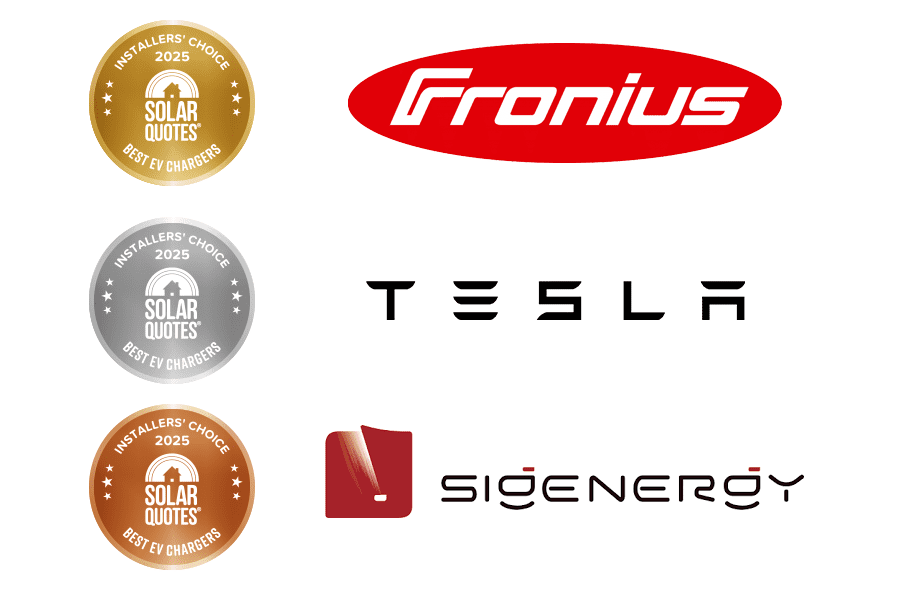
 RSS - Posts
RSS - Posts


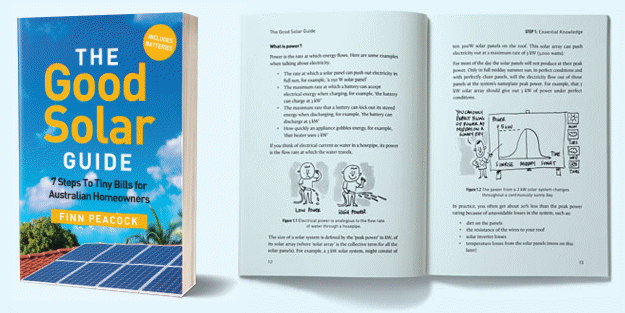
I’ve found I can control the Tesla Wall Charger completely with the Tesla app, in conjunction with a couple of simple in-built automations in the completely free Netzero app. Even the charge-on solar functionality in the Tesal app is working fine, I noted Finn you said you couldn’t get it to work properly?
The Netzero automations (I only use 2 simple ones) also allow me to prevent the car charging from the Powerwall we have at home.
I have an old Gen 2 Tesla charger which I believe will only work with a Tesla car. It came with the car when I bought it in 2019 and cost $1600 to install (had to run a new cercuit under the house to power it). I think it has 7 years warrenty becuase it came with the car which also had 7 years warrenty except I sold it and upgraded to a newer model a year ago.
I manage the Tesla car charging using Home Assistant and EMHASS using the Tesla HACS integration. It allows me to control all aspects of the car via Home Assistant.
every 60 second EMHASS calculates the best time to charge the car depending on various forecasts and live data from the home. EMHASS also calculates the best time to charge my house battery and run the pool pump using a forecast of the electricity tariffs from amber which change every 5 minutes (Feed-in tariffs vary between approx -6 cents and +18 dollars so you can make a bit of money with this variation in proces)
This is a typical days forecasts from now:
https://cruikshank-my.sharepoint.com/:i:/g/personal/robert_cruikshank_onmicrosoft_com/EeoQ85T4J09Km6WmiZor_rYBvhvKP5XidmhQw6BZConY4Q?e=0Ps26a
Not the planned car charging for the day is only peaking at avout 2kW. This is due to the system being aware that the car is nearly fully charged so its realy only using the car to avoid negative feed-in tariffs (which are forecast to be around -6 inthe middle of the day) as the house battery gets close to full. You can also see that the feed-in tariff is forecast to only get to about 22 cents tonight but the system plans to dump the 15kWh house battery at this time to make the most of the 22 cents per kWh FiT.
This will probably only result in a coupld of dollars profit for the day which will pay for the Amber Electric subscription and grid connection fee.
So I make my profits when this FiT hits $18 for a couple of hours which tends to happen on very hot days or when something goes wrong in the grid and the peaker stations have to start up.
Fascinating Robert,
Looks like you’ve got a real winner there. Now all we need is an interoperability standard so that the average punter can do something similar.
Robert, I agree with you. HA is great, but not really for the average consumer as yet.
The Integrations are becoming better, & it is really a moveable feast. Updates & upgrades happen very frequently, & the workability of the platform is improving all the time. Energy management is only one function of this Home Management system, but is the most important. To my knowledge, it is the only management system that will work with disparate equipment. In my case I have SolarEdge, Victron, ZJBeny (OCPP charger), Fronius, Selectronics, IoTaWatt (monitoring), I have yet to install 3rd party monitoring of the Grid Energy because I cannot get timely data direct from my Meter (Why not? Zigbee option on SmartMeters is mandated in Vic & SA, but not NSW or QLD: Zigbee allows direct reading of meter).
HA will also manage Multimedia devices, Robot Vacs, Security systems, Home Automation, etc etc.
Yes, I’ve been using Home Assistant for about 7 years so it’s very integrated into my home. I’ve had Solar PV and Sonnen battery for over 5 years but didn’t get into EMHASS until I moved to Amber Electric about 2 years ago and realised that I need model predictive (MPC) control to juggle all the consumption, production, and storage entities in my house.
EMHASS uses this MPC to forecast when to charge and discharge the battery, charge the car, run the pool pump etc. to get best results from given forecast of solar, feed-in and supply tariffs and house consumption forecasts. I’d never heard of MPC or EMHASS before so took a long time and a lot of community help to figure out how to set it up. But now it’s keeping me in profit all year despite charging my EV at home.
I have a well balanced system as well with 5kWp PV and 15kWh battery (but unfortunately only 3.3 kW power input/output which limits the profits I can make). But that combo stops me having to curtail solar output as I can usually capture all production during the day (I’m retired so the EV is home through the day mostly).
Modern batteries are better with up to 10 kW power. At that rate and typical spikes or $18 FiT for a couple of hours you can make $230 in a night with a 13kWh battery. That’s why some of the Amber users rushed out and bought second batteries.
I’m more technical than most home owners though even though I started my working life as a fitter and turner in 1975.
My set up is document here although this document is a little bit out of date due to the eternal upgrades of the HA system:
https://cruikshank-my.sharepoint.com/:f:/g/personal/robert_cruikshank_onmicrosoft_com/EliM7mPksJpBtEaYwf7q920BxHMk4ur2aXqf_6aQB5AO1A?e=5zmaVB
Brilliant thanks Robert.
Hi Robert
Quite fortuitous you posted your HA concept as have been discussing with my son, who is a software engineer how to go about implementing HA to manage a Sigenergy system I am looking into. The aim is to supplement the purchase of the system with the energy arbitrage you speak of. It is challenging to do the returns as there are so many variables in the Amber whole price and you mentioning it does work gives me confidence in investing in a battery system. Appreciate you sharing the docs on your one drive.
Is there a way, if you do not mind, to speak off line so I do not bother the forum with a barrage of questions?
Thanks
Peter
Yes you can find me on the Home Assistant community site where many people are discussing EMHASS. There are plenty of people there that can answer questions. You can also message me directly there.
https://community.home-assistant.io/t/emhass-add-on-an-energy-management-optimization-add-on-for-home-assistant-os-and-supervised/405649/211
How long until chargers start to be made mainstream bidirectional ?
Are any of those in the article in that category ?
From what I’ve read here and other places, I think it is just Wallbox Qua$ar that can be used on the limited number of V2G/H capable vehicles, is that correct ?
Hi Les,
Bidirectional will go mainstream a day or two after someone releases one to market.
The Quasar may still be available if Jet Charge has old stock on hand, and you pick up a new Nissan Leaf for $35,000
However the Sigenergy Bidirectional DC unit is here and just needs some software updated to make it functional, assuming you can get a car that will talk to it.
There’s plenty of demand and given a little more public awareness there will be a great uptake I’m sure.
I’m working on talking to V2Grid in Adelaide about their solution soon.
I think we should look more at our use of the vehicle and less at “how quickly can I charge it”.
We have had a grey import LEAF for nearly 5 years now and apart from one disastrous trip to a location 4 hours north we invariably charge at home and use the ‘granny charger’ to 80%, 100% if need be. We have done over 80,000 kms in the car including commuting to work until retirement 2 years ago.
My experience in long haul heavy transport tells me that you seldom see “townies” far from town so the whole range anxiety thing is either the press influence or poor planning. With increased monitoring of vehicles by either the authorities or the manufacturer before long insurance companies will be seeking “black box” information after crashes so if you have been driving beyond what they deem safe beware.
Here I mean what they say you can do if you drive a heavy vehicle for a living, then we might see them able to prove you jumped in your car at 1700 on a Friday evening and drove for 6 hours to get to your 400kms away destination despite the fact that you:
a) only ever normally drive to the shops/school or the station to commute by rail
b) have only held a licence for 2 years
But you “have to have” an EV that can do 500kms in one hit, surely not?
We plan our EV use and so far so good, we only have to use the other vehicle when the occasion arises when we want to go somewhere where charging is unavailable or unreliable. If it is your only vehicle there are sharing options which would work as needed.
So no I don’t believe that the majority of people that buy an EV need an at home 7kw charger if the average commute is 40kms far less 22kw. Naturally the power outlet for any charger should be the correct one and legally installed.
We have a dedicated circuit for the charger, solar panels and a house battery and typically now charge the car during the day but say you get home at 1900 and leave at 0600 that is 11 hours of charging and more than 150kms for most EV’s I believe.
A 500km EV WLTP range effectively means 300km or 2.5hrs on a highway road trip, given you only fast charge to 80%, the efficiency is less at higher speeds, and you don’t want to get too low. I can’t see how 400km WLTP with slow DC charging is usable for road trips unless you’re retired and/or time doesn’t matter.
We only have the 1 car at the moment, so when we upgrade to an EV our criteria is >500km WLTP and >150DC charging.
Fast charging at home makes it easier to take advantage of high solar and cheap charging windows. For example, if you work during the week you can plug it in between 11am and 2pm on the weekends and put it 42kWh of juice. If you work from home or are at home during the week then like you said, a 10A might do the job fine.
Hi Andrew
What I am trying to say is have a look at what you really do with your vehicle before you perhaps pay for an extended range battery that you will almost never use or a fast at home charger where a granny charger would work just as well.
Your feelings might be that a Merc/Tesla with a range of 800kms is the car for you but your actual circumstances might just say that the MG/BYD EV at a fraction of the price but still a good 3/400kms working range is arithmetically a better choice.
If you chose the Fronius charger for example you add a ball park $2500 to the initial cost of the car; (I am allowing $700 extra for the sparky) my point is that if you are using the car to go to the extent of it’s range and beyond regularly the 22ah charger in your garage is not much use to you once you are 300kms out, indeed if things do not go to plan as I have found the granny charger in the boot might be your best friend.
We have a relative that is has a doctorate on the subject of battery technology who has used the top of the range Merc EV for work for example, but for his personal purposes he says the vehicle he has which is one of the MGs is ideal practically and arithmetically.
Hope that clarifies my thinking for you.
On other blogs you’ve mentioned that an EV charger from the same stable as the rest of the system is more likely to integrate seamlessly, providing better control and reporting, in the same app.That convenience is handy.
However, even if that road is taken, things can go awry when the internet modem turns up its toes, and the replacement will only work on a different subnet, resulting in loss of LAN connection to the EVCE, until IP address reconfiguration is achieved by other means. The more complex the system, the more its care and feeding can be an occasional annoyance.
My Victron EVCE spontaneously stopped charging today, in a cloudless midday sky, but the MG4 sounded its horn a number of times, prompting me to manually resume charging. That was in the charger’s Manual mode, so the cause is obscure. What’s the saying? “Never mind the theory, so long as the machinery works.”
And with the EU’s Copernicus agency reporting that 18 of the last 19 months were over +1.5°C, with January 2025 at +1.74°C, we need quite a few million more photon-propelled commuter and distribution vehicles every year now.
Cheers Anthony,
I’m watching battery and V2G/H EVs to see what I can do in the coming 12 months, not going to spend a lot, a 2nd hand, 2nd Gen Leaf is fine, not going to use it apart from short suburban runs, and only charge from solar.
Not sure what charger might be around when ready to buy, will have to assess then.
I can use for V2G/H, I can use the Telsa wall charger I have here for sons X apparently, but not for the home side of use . . .
Chris, I’ll be happy to have 120 – 150km range from a 2nd hand Leaf, obviously if I can get more, so much the better for home non solar hours use.
We only use 5 – 6 kwh a night, so can probably cope next day for anything early, or it’d be charged within a few hours anyway.
We could also charge 0000 – 0600 for 8c night rate as needed.
Erik, your reply was obviously for Anthony, but yes tech can be a bit hit and miss, trialling and adapting might be needed until you strike a workable method to do what your want, especially if not all components are integrated or designed to work with something in particular.
Les, if you google “lifepo4oz”, there’s all sorts of battery kits, but also ready to use rack-mount 5 kWh to 16 kWh 48v (nominal) batteries with BMS, from different vendors. (My 46 kWh triple bank of individual prismatic LiFePO₄ cells is a bit clunky, kept in the DIY cementsheet-lined battery enclosure depicted on p75 of the issue of Renew magazine currently in newsagents.
If it takes 3 x $1600 5 kWh units to equal a Tesla Powerwall, then that’s still a third of the price, but you do have to add a battery inverter/charger. (I added MPPTs, to provide automatic off-grid “black start” after dawn, in the event of overnight complete battery discharge, and more efficient battery charging.
The 300 km range of my MG4 is the minimum I’m comfortable with, here out in the sticks, with a 65 km shopping round trip. (Yep, in town, half that would be ample, I figure.) It’s not just because there’s now several consecutive days of total overcast even in high summer, unhelpful when off-grid, but also because I am reluctant to always operate the EV battery in the top 25% of SoC. I.e. half the time I’m running the EV with under 200 km range in order to exercise a broader SoC range.
The MG4 granny charger seems to give me only 1 kW charge rate, i.e. over twelve days of 4 hrs of adequate sunlight for a full charge, worst case. That’s a long time to wait. The 46 kWh battery can substantially supplement, but there are other loads to be served, and days of autonomy to be considered. (The generator hasn’t been started in over a year.) Thus, off-grid, a 7 kW level 2 charger is essential, I submit.
Especially if able to wait another half year, it might be worth running an eye over the lowest cost new EV offerings, or a discounted Funky Cat Ora, maybe. But a good EV will outlast ICE mechanicals, with current batteries lasting longer than expected.
Nissan Leaf: Nissan is deep in the process of ceasing to exist – maybe relevant. (US$7B debt vs 86% sales decline, IIRC.)
Thanks Erik, I’ll check all that out, probably with my IT son sometime when he’s home from Melbourne.
He’s up with off grid an all sorts of systems from complex networks to remote autonomy.
I’ve been looking at early Leafs too, even for an interim period . . . we can at least use the Tesla wall charger, even if we need some sort of extra software to control it.
No V2G and some have ranges down to low 100s km, but as a virtually free to run around close by, that could suit us for around $6k – $7k, and probably less in the near future.
Even the Gen 2 Leaf which is V2G compatible apparently is floating around $15k or so now, we can get the best of both needs, local car and home battery.
Even better if it needs some minor body / paint, or hail fixed, I’m an auto body / paint man and PDR tech.
Lots to consider in the near future.
Hi,
Have a Sigenergy set-up and very unhappy with the AC integrated EV charger.
House is 3 phase and so is the battery / inverter.
However only wanted to charge as much as possible off PV, so selected the single phase AC charger (rated at 7.3kWhr).
My experiences with it has been dismay.
Setting up different charging regimes is complex in the app
Starting charging via the app is complex if you want anything other than the “default” option
The excess solar option runs at a max of 1.5kWhr
The full power option (with battery boost to SOC of 50%) imports from the grid rather than taking from the battery
Sigenergy has been non existent. They have not responded to, much less acknowledged, my various messages (via app) and e-mail. They did speak to the installer once about set-up of the battery. All communication has been through the supplier.
I have told the supplier to come and take the EV charger away.
Suggestions please on an alternative
Have had same poor experience with Sigenergy EV charger. In my case I have the 22kw 3 Phase charger (our car accepts up to 21kw) and it does not work at all in PV surplus mode. Have had since May 2025, and looking to also remove and get somethign that actually works as advertised.
My site has Sigenergy 15kw 3 phase Inverter with 22kw AC charger located in WA. The charger does not work as advertised when using PV surplus mode.
Sigenergy acknowledge the issue and their suggested “fix” is to manually start charging from the grid, then force back to PV surplus mode and hope production stays above 4.5kw and the charger stays online. As if PV production drops or load from elsewhere in the property increases EVAC will stop charging and will never restart unless you manually intervene again to force to charge form the grid.
There are also issues with Wi-Fi as it authenticates using hardware MAC address to Wireless access points. For sites with more than 1 WAP or if you change your router the EVAC wont connect and registers offline and becomes unusable in any mode.
Sigenergy Support trying to address these issues has been extremely poor with none of the above problems any closer to a resolution.
My advice, do not buy the Sigenergy AC EV charger until addressed.
Please check you have stated the warranty period for the Fronius WattPilot correctly. I checked the Fronius International Warranty Conditions available on Fronius’ website and it reads to me as a 3 year warranty if installed between 1 August 2024 and 31 December 2025. Otherwise, I guess it’s 2 years? See clause 12.2.1.
Come on Fronius, get your CFO to stand behind the brand’s reputation and approve a longer warranty period!!
Hi Clint,
There’s a link in this article